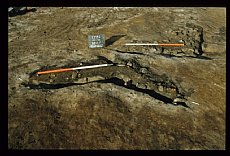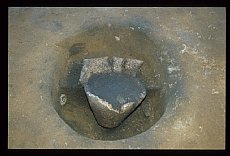Lochloy, Nairn
04 November 2019
- News Type:
- Site of the Month

© Stuart Farrell courtesy Highland HER
A proposed housing development of the south side of Lochloy Road, Nairn led to several phases of archaeological investigation at the site between 2000-2006 by Stuart Farrell. The initial stages of work comprised a desk based assessment and geophysical survey of the area, which was followed by several phases of trial trenching and excavation, first on the western side of the development site and then on the eastern side. The features discovered, at a glance, do not appear to represent a very significant site as they comprised mostly heavily truncated features, predominantly pits. However, post excavation analysis has produced a suite of dates ranging from Neolithic to Early Medieval, indicating that there is much more to the site and to the area than initially believed.
The site lay on an area of raised beach, and had been intensively ploughed over the years. This had clearly impacted the archaeology as features were all very shallow, and an enclosure visible in aerial photography from the 1970s was never located, likely having been ploughed out entirely. Phases 1-5 were focused on the west side of the site, and revealed mostly pit features. Most of these contained no finds, with the exception of two undiagnostic flints and a small amount of prehistoric pottery. Of those that were sampled, one pit was dated to the Bronze Age, and one of two features both tentatively identified as possible hearths or kilns, produced a Neolithic date. A small cist and urned cremation burial were also discovered. The cist was disturbed, but found to contain a poorly preserved and unaccompanied crouched inhumation burial. This was identified as that of a juvenile infant, which was thought to be the first of its kind in Northern Scotland, and was dated to 1875-1687 cal BC.

courtesy Highland HER
The urn was discovered in a small pit with a dark, charcoal filled fill. The urn was plain, with no decoration, placed upright and covered by a rough block of sandstone. Post-excavation analysis recovered only a very small amount of undiagnostic and fragile fragments of cremated bone within it. The fill from the pit it was buried in produced a radiocarbon date of 1890-1620 cal BC. The vessel itself could not be easily classified; it was identified as an undecorated bipartite vase, but was of much smaller size expected for such vessels, suggesting it was a domestic vessel. It was concluded that it was one of an increasing number of vessels accompanying cremations which defy easy classification, and that much more work is needed in this area regarding the use of pottery in funerary contexts during the Bronze Age in Scotland.
Trial trenching and excavation of seven areas on the east side of the site during Phases 6-9 of the project revealed kilns, hearths, pits and postholes. As with the west side of site, very few finds were made, with only four sherds of prehistoric pottery and 15 pieces of worked flint recovered. Located on a small ridge on one area of the site were 14 post holes which formed a rectangular structure. It was from a post hole in this area that the only diagnostic sherd of pottery originated: a sherd from an undecorated Early Neolithic carinated bowl. This rectangular structure may thus have represented the remains of a Neolithic timber hall. Post-excavation analysis provided an insight into several of the other features: three hearths and one pit were radiocarbon dated to the Neolithic, two post holes and a pit containing a cremation deposit were dated to the Bronze Age, another pit was dated to the Late Iron Age/Early Medieval period and two corn drying kilns (and two others of similar shape by association) were dated to the Early Medieval period.
Environmental analysis of samples taken from across the east side of the site revealed past cultivation evidence. Surviving as charred cereal grains were barley, oat, naked barley, rye, and also flax seeds. A number of culm fragments from several samples also indicated the primary processing of cereals on site, with harvesting carried by manually uprooting the cereals. The charring was likely to have taken place close by during the drying of the grains for storage or domestic use.
The function of many of the features at Lochloy is far from certain, since it is difficult to distinguish any groups of features or site types given their state of survival. The site nonetheless is significant and highlights the importance of archaeology in the plough zone; there was a scarcity of finds, features were heavily truncated, ephemeral and even lost, but post-excavation analysis revealed a multi-phase site, dating from the Neolithic to the Early Medieval. Lochloy is a clear demonstration that such disturbed sites may have more to tell us than they may appear to at first glance. Extensive sampling and thorough post excavation programmes must be built into project design as they are key to unlocking and maximising the potential of surviving deposits at disturbed sites. Development led archaeology at Lochloy has saved a site that might have otherwise eventually been completely lost through agriculture and thus an area where little was known or expected can now contribute to the wider picture of the past.
Further Information
See links below the Highland HER for full detail of the work undertaken at Lochloy.
Desk-based assessment, 2000-1: https://her.highland.gov.uk/Event/EHG852
Geophysics report, 2000: https://her.highland.gov.uk/Event/EHG707
Trial Trenching, P.1-5, 2000-1: https://her.highland.gov.uk/Event/EHG632
Excavation, P.2, 2001: https://her.highland.gov.uk/Event/EHG651
Excavation, P.1, 2002: https://her.highland.gov.uk/Event/EHG806
Excavation, P.3-5, 2003: https://her.highland.gov.uk/Event/EHG1049
Trial Trenching and excavations, P. 6-9, 2006: https://her.highland.gov.uk/Event/EHG1526
References
Report submitted by Grace Woolmer
Site of the Month Archive
- 10/04/2021 Easter Raitts township
- 02/03/2021 Lower Slackbuie, Inverness (ASDA) Neolithic site
- 01/02/2021 Balnuaran of Clava cairns
- 04/01/2021 Wilkhouse Inn
- 02/12/2020 Spinningdale Cotton Mill
- 02/11/2020 Skibo A Canadian Forestry Camp
- 01/10/2020 WWI Detonator Store, Dalmore near Invergordon
- 03/09/2020 Mesolithic Shell Midden at Sand, Wester Ross
- 08/08/2020 Kinbeachie Neolithic settlement
- 01/07/2020 Armadale Cist Burial and Stone & Timber Complex
